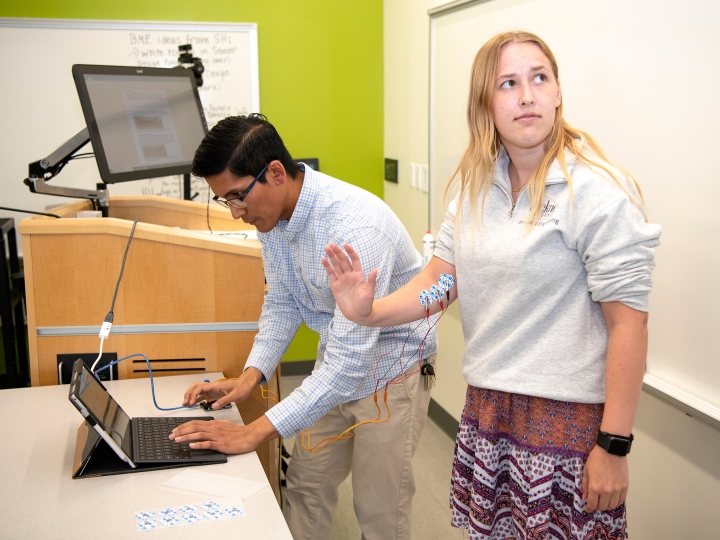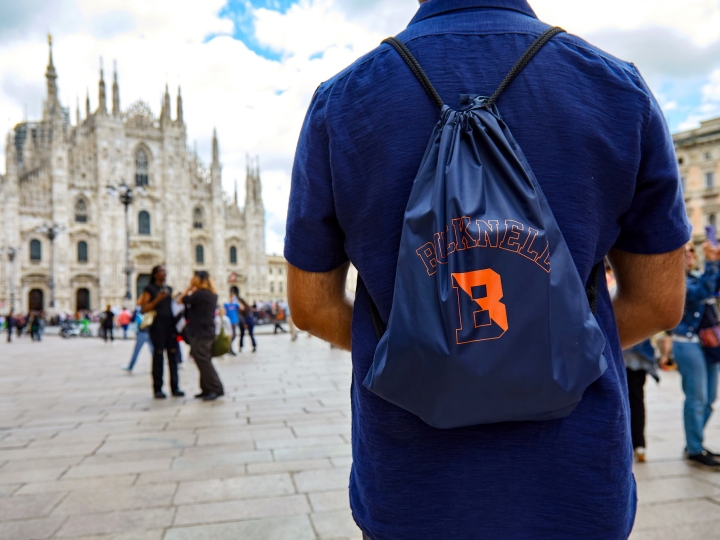
Hands-on Experiences Help Electrical & Computer Engineering Majors Find the Art in Engineering
February 4, 2019
With the help of a microscope, Hayley Reiner ’20 carefully places components on her firefly circuit board. Photo by Emily Paine, Communications
It was on an October afternoon in her junior year when Hayley Reiner '20 first experienced the art in engineering.
The electrical engineering major from Los Angeles and her lab partner were using the precision-tipped soldering irons, printed-circuit-board mill and other fabrication tools in Bucknell's Maker-E electronics makerspace to create their own circuit board — the main project of their Electrical & Computer Engineering 201 course. Reiner had used prefabricated "breadboard" circuits before, but the assignment was her first experience designing one from scratch, and it forced her to apply her creativity in ways she never had before.
Find Your Path
"It's such a small board that you're working with, so you try to find the most efficient way to place everything," Reiner said. "It's taught me that there's an art to designing electrical circuits that goes beyond just getting them to be functional."
Reiner's course was part of a new curriculum for electrical engineering and computer engineering majors in Bucknell's College of Engineering that aims to provide undergraduates with as many hands-on experiences as possible, as early as possible. The revamped educational pathway recognizes that while Bucknell graduates may not actually build circuits by hand after graduation, engaging with the practical side of their field helps them avoid easy pitfalls and better prepares them for their first jobs as technology architects.
"The first time we tried it, we couldn't even fit all our lines on the circuit," Reiner recalled. "We started over three times, and it really was a lot of hours. But I think in the end, we learned more about how everything is actually connected on the board."
Professor Philip Asare, who co-taught Reiner's course with his electrical & computer engineering colleague Professor Robert Nickel, said these sorts of activities are especially important in their field, where the connection between input and output isn't always apparent.
"You can look at a set of gears and see how it works; you can't do that with a circuit board," said Asare. "The only way to see it is to use measurement devices, and learning how to do that is not trivial."
While Reiner took the course as a junior, since 2018 the course has been included in the sophomore curriculum — part of the effort to introduce hands-on design to students earlier in their college experience. In fact, electrical & computer engineering students now undertake their first design project within their major during the second semester of their first year on campus.
Reiner's classmate Lily Parker '21 took her first major course last spring. In the class that introduced signals and sensors, Professor Stu Thompson, electrical & computer engineering, challenged his students to assemble environmental sensors to measure light, temperature, sound and other conditions inside the Dana Engineering Building, connect them to WiFi, and display their measurements on a website. The trip-ups started almost immediately, Parker recalled, but she said they were a valuable part of her learning process.
"They do a really good job of making you frustrated in the right way," said Parker, a computer engineering major from Boydon, Va. "They're doing it on purpose, because in real-life engineering jobs, we're not going to have a little bird on our shoulder telling us that this wire shouldn't be here. And it makes the end result all the better when it actually works, because you spent so much time trying to figure it out."
Early experiences like these lay the groundwork for more sophisticated projects, culminating in a yearlong senior design project in which students create or improve a real product for a real corporate or nonprofit client. The new curriculum also provides students with greater scheduling flexibility that makes it easier to study abroad or pursue an academic minor — a challenge for students at engineering schools with more rigid curricula — offering chances to gain additional skills and experiences.
Even as a sophomore, Parker said she can already tell her coursework is giving her practical know-how that will set her apart in the future.
"It's so much more vibrant than just reading a textbook and doing equations over and over," she said. "I know that if I was put into a room with someone who's only done textbook stuff, and they presented us with a real-life, physical problem, I'd be able to tell what I was looking at and how it's all connected much more quickly."

